|
Understanding the value of colored stones is vital to a successful purchase, but grading and valuation is not that easy. Indeed, it is a far more subjective process than grading diamonds.
Appreciating the meaning, and the relative importance of the 4C’s, (COLOR, CLARITY, CUTTING, and CARAT weight) is essential to evaluating the quality and value of colored gemstones. For buyers, COST and CONFIDENCE are additional issues that need to be addressed.
I. Color
“
I think it pisses God off if you walk by the color purple in a field somewhere and donít notice it.”
Alice Walker
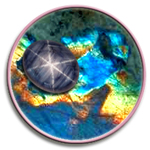 Color is the most important factor in determining the value of colored gemstones and most dealers assess the color component of a stone at between 50 – 70% of its value.
Color is the most important factor in determining the value of colored gemstones and most dealers assess the color component of a stone at between 50 – 70% of its value.
In general, a bright, rich, intense, pure, and vivid color is always best. Gemstones should not be too dark or too light. Ideally, they should look good under any light conditions. Color change stones should display a strong change in color between alternative exposure to daylight and incandescent light sources.
It is worth bearing in mind that the color of a stone is always affected by the quality of the light in which it is examined. Daylight varies throughout the day and according to global latitude. Morning and afternoon light have their own specific characteristics and many stones will appear different throughout the day.
Artificial light also affects a stone’s appearance, for example an incandescent light source enhances red tones while a fluorescent lamp brings out the greens and the blues. To help deal with these variations, many dealers use their own light source when they buy. But beware, more unscrupulous dealers may misuse these lighting techniques to inflate prices to unsuspecting buyers or unfairly to deflate prices while bargaining with sellers.
Gemological Institute of America (GIA) suggests to describe color for
colored gemstones as Hue, Tone and Saturation, where Hue describes the
dominant and any additional colors visible in a stone
Tone: the relative lightness or darkness of a hue or color sensation.
Saturation: the strength, purity or intensity of the hue present in a color
sensation. A guide of the technical aspects of color description can be
found here.
Although specific colors and the components of those colors do markedly affect the prices of most gems, personal preferences are also important. After all, who wears the jewelry, the customer or the gemologist/appraiser?
II. Clarity
“
I am just a nice, clean-cut Mongolian boy.”
Yul Brynner
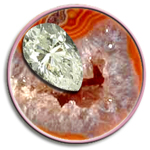 Clarity in gemstones is always an important consideration, second only to color in importance. Colored stones are almost never as clean as diamonds and they should not be judged by the same criteria. Clarity in gemstones is always an important consideration, second only to color in importance. Colored stones are almost never as clean as diamonds and they should not be judged by the same criteria.
Important stones like emeralds, rubies and alexandrites are rarely clean. Clarity and transparency are always desirable but color is still of paramount importance.
Gemstones are not created equally, some are clean and some are always included.
Gemstones that are normally found to be clean include Amethyst, Aquamarine, Blue Topaz, Citrine, Kunzite, Tanzanite, Yellow Beryl, Yellow Chrysoberyl
Gemstones that normally may have a few inclusions include Alexandrite, Andalusite, Iolite, Peridot, Rhodolite, Ruby, Sapphire, Spinel, Tourmaline, Tsavorite.
Gemstones that normally do not come clean include Emerald, Red Beryl, Rubellite, and Tourmaline.
There is no universally accepted standard for grading the clarity of colored gemstones. Although the GIA colored stone clarity grading system is a notable attempt to address the issue, it is still the subject of a great deal of discussion and debate. To read about the GIA system click here.
In some cases it is the inclusions which cause the optical phenomena and enhance a stone’s value. The best star sapphires and chrysoberyl cat’s eyes are usually translucent and it is the minute inclusions inside the stones that reflect the light and produce the star or cat’s eye effects.
III. Cut
“
Born in fire, blown by mouth and cut by hand with heart.”
Waterford glass
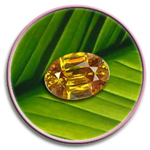 The most usual method of fashioning a gem is to cut the surface into a number of flat faces, known as facets. This gives the stone its final shape and "cut". Polishing is the oldest form of fashioning.
The most usual method of fashioning a gem is to cut the surface into a number of flat faces, known as facets. This gives the stone its final shape and "cut". Polishing is the oldest form of fashioning.
Carving produces three-dimensional objects by cutting them from a larger mass of material and engraved images are made by scratching out lines or holes to leave a raises image.
The cut is what gives a gemstone its beauty and brilliance. An ideal cut which reflects all the light in an even pattern without any darkness or windowing is usually preferable. In faceted stones, specific indices and critical angles are what produce the maximum brilliance.
Why isn’t every stone cut perfectly with ideal angles and proportions?
Nature produces rough stones in a wide variety of shapes and sizes. Many crystals may be flat or tabular. The skill of the cutter is to try to maximize the yield and produce the largest stones from the available material. Since gemstones are sold by weight, larger stones are usually worth more than smaller stones. In addition, the–per carat price of larger stones is also often higher, so that an increased carat wt. multiplied by an increased per–carat price may result in an exponential jump in price for a relatively small difference in weight.
What about windows in gemstones?
Jewelers, gemologists and gem dealers always talk about windows. A window is something we can look through, and indeed, in the gems business windowed stones are those that are usually too flat or poorly proportioned resulting in stones one can see right through. The window causes an absence of reflection in the center of the stone that reduces the amount of light reflected thus reducing the brilliance of the stone.
So why do some gems still have windows?
Some stones are especially rare in larger sizes. A flat and windowed 3ct.+ Burmese ruby would almost always be worth more than the same stone perfectly cut to be a 1ct.+ stone. There are no fixed rules about cutting and the ultimate value of a particular stone after faceting. A skilled cutter’s careful consideration of yield and proportion, as well as positioning of un–removable inclusions will always produce the best result.
How does color intensity affect the cut?
The density or intensity of a color is always an important consideration for cutters. Any gemstone will become lighter as its size is reduced. The color of over-dark stones will improve as their size is reduced while light stones will become even lighter and lose some of their value as a result of cutting.
Because of their beauty and rarity, gemstones are valuable – especially rare stones with good color and clarity. Well-cut and proportioned stones look better and are easier to sell. As dealers and cutters we frequently re-cut poorly faceted stones, using our experience to select those with color and clarity and then drawing out their hidden potential, while still maximizing final weight and value.
IV. Carat
“
Now cheaply bought for thrice their weight in gold.”
John Bartlett
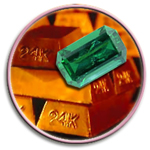 A carat is a metric unit of weight used in the gemstone industry to describe how much a gemstone weighs. A carat is equal to one fifth of a gram and there are five carats in one gram. Thus when referring to decimal fractions of a carat, a point is equal to .01 (1/100th) of a carat.
A carat is a metric unit of weight used in the gemstone industry to describe how much a gemstone weighs. A carat is equal to one fifth of a gram and there are five carats in one gram. Thus when referring to decimal fractions of a carat, a point is equal to .01 (1/100th) of a carat.
Valuable gemstones are generally sold by weight and not by size. Less valuable materials can be cut into standard calibrated sizes commonly used by jewelry designers.
Larger stones are always rarer and per-carat prices will usually be more than equivalent to similar stones in a smaller size. Relationships between per-carat prices and sizes will vary with each specific gemstone group. As a starting point, we use the following guidelines, albeit with great flexibility:
(1/2 – 1cts) = price($x/cts.)
(1 – 2cts) = price($2x/cts.)
(2 – 3cts) = price($4x/cts.)
(3cts.+) = price($4-5x/cts.+)
(5cts.+) = much price variation.
Carat weights do not determine size. The density of gems varies from very light stones like opal to especially heavy stones like sphalerite or zircon. A 1 ct. round diamond measures 6.25mm. An opal the same size might only weigh .70cts. while a zircon that size could weigh 1.40cts.
V. Cost
“
When we mean to build, We first survey the plot, then draw the model; And when we see the figure of the house, Then must we rate the cost of the erection.”
William Shakespeare
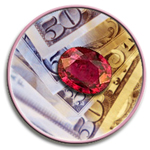 Like any other commodity, supply and demand determine the prices of gemstones. Fine gems are never available in quantity and demand is always strong with speculative gem dealers buying the best, the biggest and the rarest stones whenever they can.
Like any other commodity, supply and demand determine the prices of gemstones. Fine gems are never available in quantity and demand is always strong with speculative gem dealers buying the best, the biggest and the rarest stones whenever they can.
The reality of most mining operations is they are "here today, and gone tomorrow" operations. Especially in developing nations, new discoveries will attract tens of thousands of hand miners and diggers but few will strike it rich.
Deposits are quickly depleted and mining stops or becomes too expensive when the gem deposits near the surface are exhausted. Deeper mining is more expensive; it requires more machinery, more fuel, and much more time and effort to produce the stones. As the depth increases, the gems become more expensive and when the price of production exceeds the market price, the mining will stop.
Supply is unpredictable and even if a deposit can continue to be mined, conflicts over royalties, ownership issues, and political, tribal, or power struggles will restrict or inhibit the production sooner or later.
Supply may be unpredictable, but so too is demand, which can be promoted, or simply be the result of some unforeseen fashion trend due to the popularity of a certain color, or because of the association of a particular stone with some famous personality.
TV shopping channels can and do create demand for previously unknown materials. Tanzanite is a good example. Relatively unknown 10 years ago, demand for it sky-rocketed not only because of its beauty but because it was available in sufficient quantity and at a price attractive enough to be promoted on TV.
The DeBeers group is another example. Diamonds are popular because DeBeers spends millions of dollars a year promoting them! How would we know that "a diamond is forever" if they had not told us?
VI. Confidence
“
If appearances are deceitful, then they do not deserve any confidence when they assert what appears to them to be true.”
Diogenes Laertius
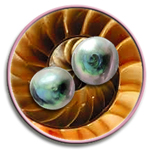 Successful gem buying at a professional level requires years’ of experience. As a hobbyist or collector, gem buying can be fun and profitable. As a buyer or an investor – do your research! Go to jewelry stores, visit websites or checkout some of the online auctions – shop around. Gain knowledge and confidence! Successful gem buying at a professional level requires years’ of experience. As a hobbyist or collector, gem buying can be fun and profitable. As a buyer or an investor – do your research! Go to jewelry stores, visit websites or checkout some of the online auctions – shop around. Gain knowledge and confidence!
One of the best ways to learn is to attend any of the many gem and mineral shows that are in your local area and are open to the public. Many of the shows are sponsored by local clubs or by commercial show promoters.
Finding a good reliable source of gems is one thing, but you must also know and trust your supplier. Are they members of trade organizations? How long have they been in business? Do they have a good selection? Do they make their own jewelry? Do they understand colored stones?
What about internet suppliers? Are the pictures clear and focussed? Are the images enhanced? What about return policies? Do they have references? What about enhancements and disclosures? Do they offer internationally-recognized certificates of gem stone identification? Are they knowledgeable certified gemologists? Are they quick to respond to questions? What about insurance? What about testimonials?
Knowledge and confidence are the real secrets to buying gemstones correctly and at a reasonable price. And because grading and pricing is so subjective, even experienced dealers like to buy from their regular suppliers.
Colored stones present their own particular challenges. The market for them is highly fragmented, with no central marketing organization; each stone may have several countries of origin and the prices of the gems are constantly changing, so it is the dealers, the jewelers, and the customers themselves who make the market in colored stones – after all, that’s what makes colored gemstones so exciting!
|





